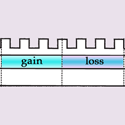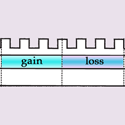Absorbing lasers
In a laser, the gain medium inside the optical resonator emits a monochromatic, coherent output wave when the amplification of photons inside the resonator is sufficient to balance the loss due to light exiting the resonator cavity. A device that performs the reverse of this process, called a coherent perfect absorber (CPA), was proposed earlier this year by a group at Yale University [1,2]. A CPA perfectly absorbs incoming light, provided it has a specific spatial mode, frequency, and phase. This can be achieved by replacing the laser gain medium with an absorbing medium such that the Maxwell equations are satisfied by an incoming wave, which is the time-reversed counterpart of the laser output mode.
Since it is the sign of the imaginary part of the dielectric constant that determines whether a medium provides gain or loss, different optical media are generally required for a laser and a CPA. Writing in Physical Review A, Stefano Longhi of the Politecnico di Milano, Italy, has now shown that it is possible to achieve both a laser and a CPA in a single device by invoking the parity-time ( ) symmetry condition . Longhi goes on to give a simple recipe for the construction of such a device that involves two symmetric regions with equal magnitude gain and loss in what is called a distributed-feedback dielectric structure. At the threshold for lasing, such a device would be able to simultaneously emit and absorb coherent light beams. Although a -symmetric absorbing laser has not yet been demonstrated it is likely that this will happen in the near future, adding a new and versatile device to the toolbox of optical physicists. –Mark Saffman
[1] Y. D. Chong, L. Ge, H. Cao, and A. D. Stone, Phys. Rev. Lett. 105, 053901 (2010).
[2] S. Longhi, Physics 3, 61 (2010).





